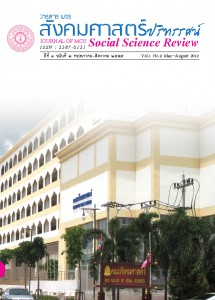การศึกษาเปรียบเทียบความเสี่ยงและอัตราผลตอบแทนของหลักทรัพย์หมวดธุรกิจวัสดุ ก่อสร้างโดยใช้แบบจำลอง CAPM : กรณีศึกษาหลักทรัพย์DCON, DRT, Q-CON, RCI, SUPER, และ TASCO
คำสำคัญ:
หลักทรัพย์หมวดธุรกิจวัสดุก่อสร้าง, CAPM (Capital Asset Pricing Model), ค่าสัมประสิทธิ์เบต้า, ความเสี่ยงหลักทรัพย์หมวดธุรกิจวัสดุก่อสร้าง, ผลตอบแทนหลักทรัพย์หมวด ธุรกิจวัสดุก่อสร้างบทคัดย่อ
การศึกษาวิจัยครั้งนี้มีวัตถุประสงค์ ๑) เพื่อศึกษาอัตราผลตอบแทนและความเสี่ยงของแต่ละหลักทรัพย์หมวดธุรกิจวัสดุก่อสร้าง และ ๒) เพื่อศึกษาเปรียบเทียบอัตราผลตอบแทนที่คาดหวังภายใต้แบบจำลองการกำหนดราคาหลักทรัพย์ (Capital Asset Pricing Model; CAPM) กับอัตราผลตอบแทนที่เกิดขึ้นจริงของหลักทรัพย์หมวดธุรกิจวัสดุก่อสร้าง ข้อมูลรวบรวมจากรายงานการซื้อขายหลักทรัพย์ของตลาดหลักทรัพย์ประเทศไทยประกอบด้วย SET INDEX และราคาหลักทรัพย์หมวดธุรกิจวัสดุก่อสร้าง ซึ่งจะทำการศึกษาหลักทรัพย์หมวดธุรกิจวัสดุก่อสร้างที่จดทะเบียนในตลาดหลักทรัพย์แห่งประเทศไทยจำนวน ๖ หลักทรัพย์ได้แก่บริษัทดีคอนโปรดักส์ จำกัด (มหาชน) :DCON, บริษัท ผลิตภัณฑ์ตราเพชร จำกัด (มหาชน) : DRT, บริษัท ควอลิตี้คอนสตรัคชั่นโปรดัคส์จำกัด (มหาชน) : Q-CON, บริษัท โรแยล ซีรามิค อุตสาหกรรม จำกัด (มหาชน) : RCI, บริษัทซุปเปอร์บล๊อก จำกัด (มหาชน) : SUPER และบริษัท ทิปโก้แอสฟัลท์ จำกัด (มหาชน) : TASCOทำการศึกษาโดยใช้ข้อมูลทุติยภูมิเป็นรายวัน ตั้งแต่วันที่ ๑ มกราคม พ.ศ. ๒๕๕๔ ถึงวันที่ ๓๑ธันวาคม พ.ศ. ๒๕๕๕ รวมเป็นระยะเวลา ๔๘๙ วันทำการ เครื่องมือที่ใช้ในการศึกษา ได้แก่ การวิเคราะห์จากทฤษฎี CAPM โดยใช้เส้นตลาดหลักทรัพย์ Securities Market Line (SML)ผลการศึกษาพบว่า เมื่อเปรียบเทียบอัตราผลตอบแทนของหลักทรัพย์หมวดธุรกิจวัสดุก่อสร้างกับผลตอบแทนของตลาด พบว่าหลักทรัพย์หมวดธุรกิจวัสดุก่อสร้างที่ให้อัตราผลตอบแทนสูงกว่าตลาด มีจำนวน ๔ หลักทรัพย์ คือ Q-CON, SUPER, DCON และ RCI ตามลำดับและหลักทรัพย์หมวดธุรกิจวัสดุก่อสร้างที่ให้อัตราผลตอบแทนต่ำกว่าตลาด มีจำนวน ๒ หลักทรัพย์ คือ DRT และTASCO ตามลำดับ ค่าความเสี่ยงที่วัดโดยค่าเบต้าผลการศึกษาพบว่าความเสี่ยงของตลาดหลักทรัพย์มีค่าเท่ากับ ๑.๓๒๗๔ เมื่อเปรียบเทียบกับอัตราผลตอบแทนของหลักทรัพย์ในหมวดธุรกิจวัสดุก่อสร้างพบว่าหลักทรัพย์หมวดธุรกิจวัสดุก่อสร้าง TASCO, SUPER, RCI, DRT, Q-CON และ DCONมีค่าความเสี่ยงที่ต่ำกว่าตลาด และเมื่อนำอัตราผลตอบแทนที่คาดว่าจะได้รับของหลักทรัพย์หมวดธุรกิจวัสดุก่อสร้างเทียบกับอัตราผลตอบแทนที่ต้องการตามแบบจำลอง CAPM พบว่าหลักทรัพย์หมวดธุรกิจกลุ่มวัสดุก่อสร้างที่มีมูลค่าต่ำกว่าที่ควรจะเป็น (Undervalued) มี ๕ หลักทรัพย์ คือหลักทรัพย์ DCON, DRT, Q-CON, RCI และ SUPER และหลักทรัพย์หมวดธุรกิจวัสดุก่อสร้างที่มีมูลค่าสูงกว่าที่ควรจะเป็น (Overvalued) มี ๑ หลักทรัพย์ คือ หลักทรัพย์ TASCO
เอกสารอ้างอิง
วิไลพรรณ ตาริชกุล. รูปแบบจำลอง CAPM การศึกษาเปรียบเทียบความเสี่ยงและอัตราผลตอบแทนของหลักทรัพย์กลุ่มธนาคาร. วิทยานิพนธ์บริหารธุรกิจมหาบัณฑิต. บัณฑิตวิทยาลัย :มหาวิทยาลัยรามคำแหง, ๒๕๕๑.
สิริวรรณ โฉมจำรูญ. หลักและนโยบายการลงทุน. พิมพ์ครั้งที่ ๒. กรุงเทพมหานคร : ทีพีเอ็นเพรส, ๒๕๔๘.
อัญญา ขันธวิทย์. การวิเคราะห์ความเสี่ยงจากการลงทุนในหลักทรัพย์. กรุงเทพมหานคร : ตลาด หลักทรัพย์แห่งประเทศไทย, ๒๕๔๗.
The Thai Bond Market Association. (2011-2012). Treasury bill. [Online]. Sources : from http://www.thaibma.or.th/priceyield/TBillQuoted.aspx [February 26 2012].
Weera Weerakhajornsak. Kittiphun Khongsawatkiat. Asset Pricing in Energy Sector :The Evidence from Stock Exchange of Thailand. The First National
Conference on Graduate Research for Business Management ๒๐๐๘. May ๒๙,๒๐๐๘. University of the Thai Chamber of Commerce.
ดาวน์โหลด
เผยแพร่แล้ว
รูปแบบการอ้างอิง
ฉบับ
ประเภทบทความ
สัญญาอนุญาต
ลิขสิทธิ์ (c) 2018 วารสาร มจร สังคมศาสตร์ปริทรรศน์

อนุญาตภายใต้เงื่อนไข Creative Commons Attribution-NonCommercial-NoDerivatives 4.0 International License.
เพื่อให้เป็นไปตามกฎหมายลิขสิทธิ์ ผู้นิพนธ์ทุกท่านต้องลงลายมือชื่อในแบบฟอร์มใบมอบลิขสิทธิ์บทความให้แก่วารสารฯ พร้อมกับบทความต้นฉบับที่ได้แก้ไขครั้งสุดท้าย นอกจากนี้ ผู้นิพนธ์ทุกท่านต้องยืนยันว่าบทความต้นฉบับที่ส่งมาตีพิมพ์นั้น ได้ส่งมาตีพิมพ์เฉพาะในวารสาร มจร สังคมศาสตร์ปริทรรศน์ เพียงแห่งเดียวเท่านั้น หากมีการใช้ภาพหรือตารางหรือเนื้อหาอื่นๆ ของผู้นิพนธ์อื่นที่ปรากฏในสิ่งตีพิมพ์อื่นมาแล้ว ผู้นิพนธ์ต้องขออนุญาตเจ้าของลิขสิทธิ์ก่อน พร้อมทั้งแสดงหนังสือที่ได้รับการยินยอมต่อบรรณาธิการ ก่อนที่บทความจะได้รับการตีพิมพ์ หากไม่เป็นไปตามข้อกำหนดเบื้องต้น ทางวารสารจะถอดบทความของท่านออกโดยไม่มีข้อยกเว้นใดๆ ทั้งสิ้น





